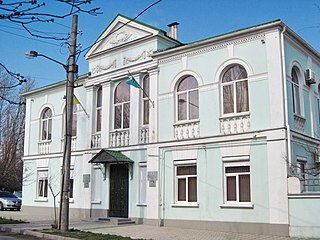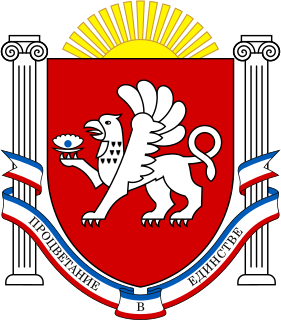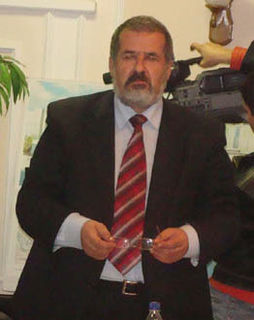
The State Council of Crimea is the parliament of the Republic of Crimea. It had previously been called the 'Supreme Council of Crimea but changed its name in March 2014 following a vote by the Ukrainian parliament to dissolve the Supreme Council of Crimea. The Parliament is housed in the Parliament building in the centre of Simferopol.

The Mejlis of the Crimean Tatar People is the single highest executive-representative body of the Crimean Tatars in period between sessions of the Qurultay of the Crimean Tatar People.
The politics of Crimea today is that of the Republic of Crimea on one hand, and that of the federal city of Sevastopol on the other, within the context of the largely unrecognised annexation of Crimea by the Russian Federation in March 2014.

The Party "Soyuz" is a national political party of Ukraine that is mostly based in Crimea. It was registered in June 1997 under a registration number 867.

The 2006 Crimean parliamentary election were held on 26 March 2006. These were the first elections to the Verkhovna Rada of Crimea, which were conducted on the proportional election system. In order to gain representation in the Parliament of the Autonomous Republic of Crimea, the party or bloc had to get at least 3% of the vote.

The 2010 Crimean parliamentary election were held on 31 October 2010 as a part of the general 2010 Ukrainian local elections. Unlike the previous election to the Verkhovna Rada of Crimea, they were conducted on the mixed member proportional representation system. In order to gain representation in the Parliament of the Autonomous Republic of Crimea, a party or bloc had to garner at least 3 percent of the total vote. The Party of Regions won the elections with an overwhelming majority.

Verkhovna Rada of Crimea or the Supreme Council of Crimea, officially the Supreme Council of the Autonomous Republic of Crimea was a Ukrainian legislative body of the Autonomous Republic of Crimea before the annexation of Crimea by the Russian Federation in 2014.

Anatolii Volodymyrovych Mohyliov is a Ukrainian politician. He is the former Prime Minister of Crimea and former Ukrainian Minister of Internal Affairs.

Russkoye Yedinstvo was a political party in Crimea, registered in October 2008. On 30 April 2014 a Kiev Court banned the party "from activity on the territory of Ukraine". Party leader Sergey Aksyonov was instrumental in making possible the annexation of Crimea by the Russian Federation. The party was based in Crimea, which has a Russian-speaking majority. The party was dissolved a year after the annexation of Crimea.
Party of Economic Revival was a political party in Ukraine set up by former communists in Crimea in November 1992 as Party of Economic Revival of Crimea. It was suspected of having ties with organized crime. The party was dissolved by the Ukrainian Ministry of Justice in 2003.

Refat Abdurakhmanovich Chubarov is a Ukrainian politician and public figure, leader of the Crimean Tatar national movement in Ukraine and worldwide.

A controversial referendum on the status of Crimea was held on March 16, 2014, by the legislature of the Autonomous Republic of Crimea and by the local government of Sevastopol. The referendum requested local populations whether they wanted to join Russia as a federal subject, or if they wanted to restore the 1992 Crimean constitution and Crimea's status as a part of Ukraine. After the events of Euromaidan, the referendum was held during a Russian military takeover of Crimea. The referendum is not internationally recognized by most countries.

Sergey Valeryevich Aksyonov is the Head and Prime Minister of the Republic of Crimea from 2014. which is an internationally disputed federal subject of Russia located on the Crimean Peninsula.
A three-part referendum was held in Crimea on 27 March 1994 alongside regional and national elections. Voters were asked whether they were in favour of greater autonomy within Ukraine, whether residents should have dual Russian and Ukrainian citizenship, and whether presidential decrees should have the status of laws. All three proposals were approved.
Parliamentary elections were held in Crimea on 27 March 1994. The result was a victory for Bloc Russia, which won 57 of the 100 seats in the Supreme Council.
Parliamentary elections were held in Crimea on 29 March 1998. The Communist Party of Ukraine emerged as the largest faction in the Supreme Council, with 38 of the 100 seats, although 47 seats were won by independents.

Vladimir Andreyevich Konstatinov is a Crimean and Russian politician serving as Chairman of the State Council of the Republic of Crimea from 17 March 2014.
![Autonomous Republic of Crimea administrative division of Ukraine since 1992, not occupying the whole peninsula [see Q15966495 for Russian subdivision proclaimed in 2014]](https://upload.wikimedia.org/wikipedia/commons/thumb/a/aa/Flag_of_Crimea.svg/320px-Flag_of_Crimea.svg.png)
The Autonomous Republic of Crimea is, de jure, an autonomous republic of Ukraine encompassing most of Crimea, though, de facto, it was annexed by the Russian Federation in 2014.
Qurultai-Rukh is a regional organization of the People's Movement of Ukraine and a regional council's faction that consists of members from the Qurultay of the Crimean Tatar People in the Supreme Council of Crimea. The association of Crimean Tatars with the People's Movement of Ukraine started back in 1998. The faction supports the signing of the Ukrainian association with the European Union.

Parliamentary elections took place in the Republic of Crimea on 14 September 2014. These were the first elections since Crimea's annexation into the Russian Federation earlier that year. The outcome was an overwhelming victory for President Vladimir Putin's United Russia party.
















![Autonomous Republic of Crimea administrative division of Ukraine since 1992, not occupying the whole peninsula [see Q15966495 for Russian subdivision proclaimed in 2014]](https://upload.wikimedia.org/wikipedia/commons/thumb/a/aa/Flag_of_Crimea.svg/320px-Flag_of_Crimea.svg.png)
